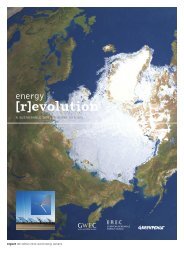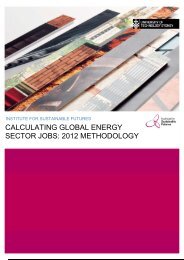download the mexico energy revolution scenario
download the mexico energy revolution scenario
download the mexico energy revolution scenario
You also want an ePaper? Increase the reach of your titles
YUMPU automatically turns print PDFs into web optimized ePapers that Google loves.
WORLD ENERGY [R]EVOLUTION<br />
A SUSTAINABLE ENERGY OUTLOOK<br />
8<br />
<strong>energy</strong> technologies | RENEWABLE ENERGY TECHNOLOGIES<br />
ocean <strong>energy</strong><br />
tidal power Tidal power can be harnessed by constructing a dam<br />
or barrage across an estuary or bay with a tidal range of at least<br />
five metres. Gates in <strong>the</strong> barrage allow <strong>the</strong> incoming tide to build up<br />
in a basin behind it. The gates <strong>the</strong>n close so that when <strong>the</strong> tide flows<br />
out <strong>the</strong> water can be channelled through turbines to generate<br />
electricity. Tidal barrages have been built across estuaries in<br />
France, Canada and China but a mixture of high cost projections<br />
coupled with environmental objections to <strong>the</strong> effect on estuarial<br />
habitats has limited <strong>the</strong> technology’s fur<strong>the</strong>r expansion.<br />
wave and tidal stream power In wave power generation, a<br />
structure interacts with <strong>the</strong> incoming waves, converting this <strong>energy</strong><br />
to electricity through a hydraulic, mechanical or pneumatic power<br />
take-off system. The structure is kept in position by a mooring<br />
system or placed directly on <strong>the</strong> seabed/seashore. Power is<br />
transmitted to <strong>the</strong> seabed by a flexible submerged electrical cable<br />
and to shore by a sub-sea cable.<br />
In tidal stream generation, a machine similar to a wind turbine<br />
rotor is fitted underwater to a column fixed to <strong>the</strong> sea bed; <strong>the</strong><br />
rotor <strong>the</strong>n rotates to generate electricity from fast-moving currents.<br />
300 kW prototypes are in operation in <strong>the</strong> UK.<br />
Wave power converters can be made up from connected groups of<br />
smaller generator units of 100 – 500 kW, or several mechanical or<br />
hydraulically interconnected modules can supply a single larger<br />
turbine generator unit of 2 – 20 MW. The large waves needed to<br />
make <strong>the</strong> technology more cost effective are mostly found at great<br />
distances from <strong>the</strong> shore, however, requiring costly sub-sea cables to<br />
transmit <strong>the</strong> power. The converters <strong>the</strong>mselves also take up large<br />
amounts of space. Wave power has <strong>the</strong> advantage of providing a<br />
more predictable supply than wind <strong>energy</strong> and can be located in <strong>the</strong><br />
ocean without much visual intrusion.<br />
There is no commercially leading technology on wave power<br />
conversion at present. Different systems are being developed at sea<br />
for prototype testing. The largest grid-connected system installed so<br />
far is <strong>the</strong> 2.25 MW Pelamis, with linked semi-submerged<br />
cyclindrical sections, operating off <strong>the</strong> coast of Portugal. Most<br />
development work has been carried out in <strong>the</strong> UK.<br />
Wave <strong>energy</strong> systems can be divided into three groups, described below.<br />
• shoreline devices are fixed to <strong>the</strong> coast or embedded in <strong>the</strong><br />
shoreline, with <strong>the</strong> advantage of easier installation and<br />
maintenance. They also do not require deep-water moorings or<br />
long lengths of underwater electrical cable. The disadvantage is<br />
that <strong>the</strong>y experience a much less powerful wave regime. The most<br />
advanced type of shoreline device is <strong>the</strong> oscillating water column<br />
(OWC). One example is <strong>the</strong> Pico plant, a 400 kW rated shoreline<br />
OWC equipped with a Wells turbine constructed in <strong>the</strong> 1990s.<br />
Ano<strong>the</strong>r system that can be integrated into a breakwater is <strong>the</strong><br />
Seawave Slot-Cone converter.<br />
• near shore devices are deployed at moderate water depths (~20-<br />
25 m) at distances up to ~500 m from <strong>the</strong> shore. They have <strong>the</strong><br />
same advantages as shoreline devices but are exposed to stronger,<br />
more productive waves. These include ‘point absorber systems’.<br />
• offshore devices exploit <strong>the</strong> more powerful wave regimes available<br />
in deep water (>25 m depth). More recent designs for offshore<br />
devices concentrate on small, modular devices, yielding high power<br />
output when deployed in arrays. One example is <strong>the</strong> AquaBuOY<br />
system, a freely floating heaving point absorber system that reacts<br />
against a submersed tube, filled with water. Ano<strong>the</strong>r example is <strong>the</strong><br />
Wave Dragon, which uses a wave reflector design to focus <strong>the</strong> wave<br />
towards a ramp and fill a higher-level reservoir.<br />
1<br />
© USCHI HERING/DREAMSTIME<br />
9<br />
2 3<br />
© MCDONNELL/ISTOCK<br />
© MAXFX/DREAMSTIME<br />
images 1. BIOMASS CROPS. 2. OCEAN ENERGY. 3. CONCENTRATING SOLAR POWER (CSP).<br />
98



![Energy [R]evolution - European Commission](https://img.yumpu.com/49109324/1/184x260/energy-revolution-european-commission.jpg?quality=85)


![5905 gp [eu rev]csfr4.qxd - Energy [R]evolution](https://img.yumpu.com/42305023/1/184x260/5905-gp-eu-revcsfr4qxd-energy-revolution.jpg?quality=85)


![5905 gp [eu rev]csfr4.qxd - Energy [R]evolution](https://img.yumpu.com/28729264/1/184x260/5905-gp-eu-revcsfr4qxd-energy-revolution.jpg?quality=85)